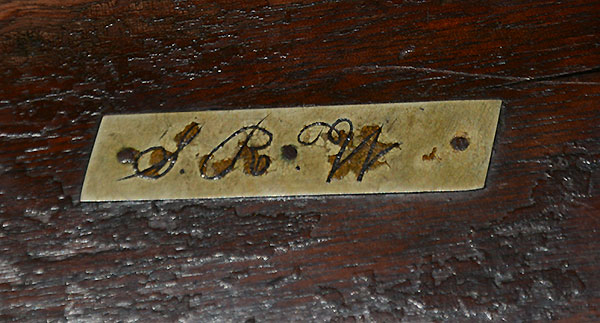site search
online catalog
CIVIL WAR SPENCER M1860 CAVALRY CARBINE

Hover to zoom


















$2,295.00 SOLD
Quantity Available: None
Item Code: 172-6026
This is a good, representative Spencer carbine, likely brought home by a veteran, sporterized slightly for use around the farm or taken west in the early years after the war. The carbine is the standard configuration Model 1860: 39 inches long, 22-inch barrel, two-piece walnut stock and 7-shot tubular magazine inserted through the buttplate. These were strongly built repeating carbines that become the dominant cavalry arm in last half of the war, combining compact construction, .52 caliber waterproof rimfire cartridges, and sheer firepower. Invented by Christopher Spencer, rifles for the army and navy were produced first, but by October 1863 the first of many carbine deliveries took place, reaching something in range of 60-62,000 by mid-April 1865. Scores of cavalry regiments carried Spencers: units from New York, Michigan, Wisconsin, New Jersey, and Indiana just to name a few. They were well liked by those who carried them and respected by those who faced their fire. For the Civil War or US cavalry collector they are a key weapon to have in a collection.
Serial numbered 49730, this one dates toward the end of the war and shows a round brass badge inlet in the right buttstock perhaps relating to a veteran’s service, along with a rectangular plaque in laid in the left bearing the initials “S.R.W.” in script, the rear sight removed and replaced by simple fixed, notched sight, and the forestock shortened slightly and dressed up or reinforced, by a blunt metal nose cap. The barrel is smooth metal, light brown from the muzzle to breech, with the barrel band pitted. The rear sight appears to have been removed in favor of a fixed, notched sight first placed close to the barrel band and then moved to the rear. The top of the receiver is smooth metal and clearly stamped, “SPENCER REPEATING / RIFLE CO. BOSTON MASS / PAT’D MARCH 6, 1860.” The sides of the receiver, hammer and lockplate are gray in color and finely peppered with a pebbly surface, likely cleaned some years ago. The buttplate shows dark, with scaling. The wood shows use, with various bumps, scratches, with patchy finish, likely from a damp environment, and shows some chipping along the upper edge of the lockplate and the typical narrow “Spencer crack” on the left buttstock in line with the magazine tube, the inletting for which typically weakened the wood along that line.
The badge inlet on the flat of the right butt flat is brass, showing remnants of gilt finish mixed with dark age stains. It has a raised central, plain circle and a narrow plain band midway to the edge, with the surface covered with the curving intersecting lines of overlapping, engraved or stamped circles. The disk was, of course, the badge of the First Army Corps, so it is possible a veteran with prior service in that corps inlaid it as a memento, though the corps had been amalgamated into the Fifth Army Corps long before the carbine was made and the only cavalry associated with it would have been headquarters detachments.
The serial number is bracketed by carbines recorded in 1865 in the hands of Co. E 7th Ind. Cav. (#49724) and Co. F 2nd WI. Cav. (#49744.) A miss is as good as a mile in serial numbers, unfortunately. A quick check of those units does reveal several candidates if this carbine did see service with them, but middle initials are not always listed to eliminate or include candidates and it would entail additional work to see if one of them had prior service in a First Corps unit to make sense of the badge, though we are well aware of both Indiana and Wisconsin soldiers in the First Corps: notably the Iron Brigade.
The mechanics are good. The magazine tube draws fine from the stock. The bore is dark, with scattered, moderate pitting, but shows rifling. The badge and plaque are interesting and worth some further research, but the carbine clearly in any case both saw use and had both practical and sentimental value to the owner. [sr][ph:L]
DISCLAIMER: All firearms are sold as collector's items only - we do not accept responsibility as to the shooting safety or reliability of any antique firearm. All firearms are described as accurately as possible, given the restraints of a catalog listing length. We want satisfied customers & often "under" describe the weapons. Any city or state regulations regarding owning antique firearms are the responsibility of the purchaser. All firearms are "mechanically perfect" unless noted, but again, are NOT warranted as safe to fire.
~~~~~~~~~~~~~~~~~~~~~~~~~~~~~~~~~~~
THIS ITEM, AS WITH ALL OTHER ITEMS AVAILABLE ON OUR WEB SITE,
MAY BE PURCHASED THROUGH OUR LAYAWAY PROGRAM.
CLICK HERE FOR OUR POLICIES AND TERMS.
THANK YOU!
Inquire About CIVIL WAR SPENCER M1860 CAVALRY CARBINE
Most Popular
Historical Firearms Stolen From The National Civil War Museum In Harrisburg, Pa »
Theft From Gravesite Of Gen. John Reynolds »
Selection Of Unframed Prints By Don Troiani »
Fine Condition Brass Infantry Bugle Insignia »
Large English Bowie Knife With Sheath 1870’S – 1880’S »
Imported (Clauberg) Us Model 1860 Light Cavalry Officer's Saber »
featured item
IDENTIFIED CONFEDERATE CAPTAIN’S FROCK COAT OF CAPTAIN PHARES WALDO SHEARER, 45th MISSISSIPPI, WITH 28-PAGE REMINSCENCES AND VETERAN’S BADGE- HE EXCHANGED SALUTES WITH THE WOUNDED JOHN BELL HOOD AT CHICKAMAUGA
This coat came directly out of the family along with a reunion badge and type-written copy of the officer’s 1906 reminiscences. The coat was formerly in the collection of Steve Mullinax, is accompanied by a file containing details of its… (1179-179). Learn More »


